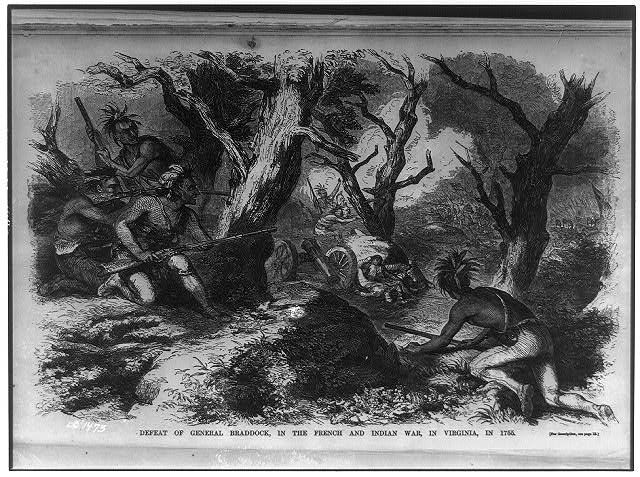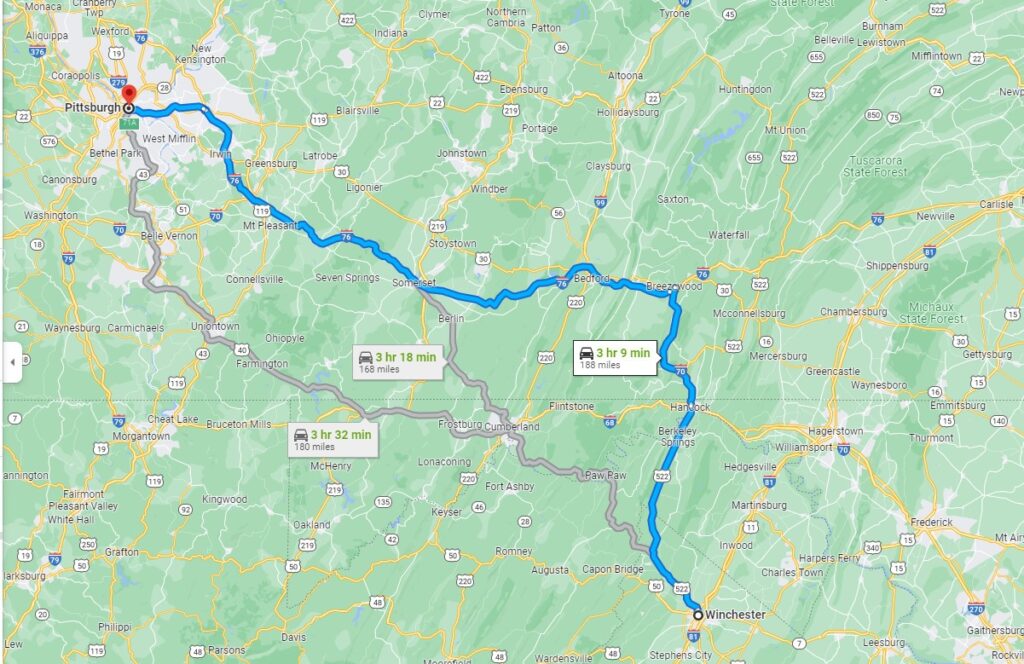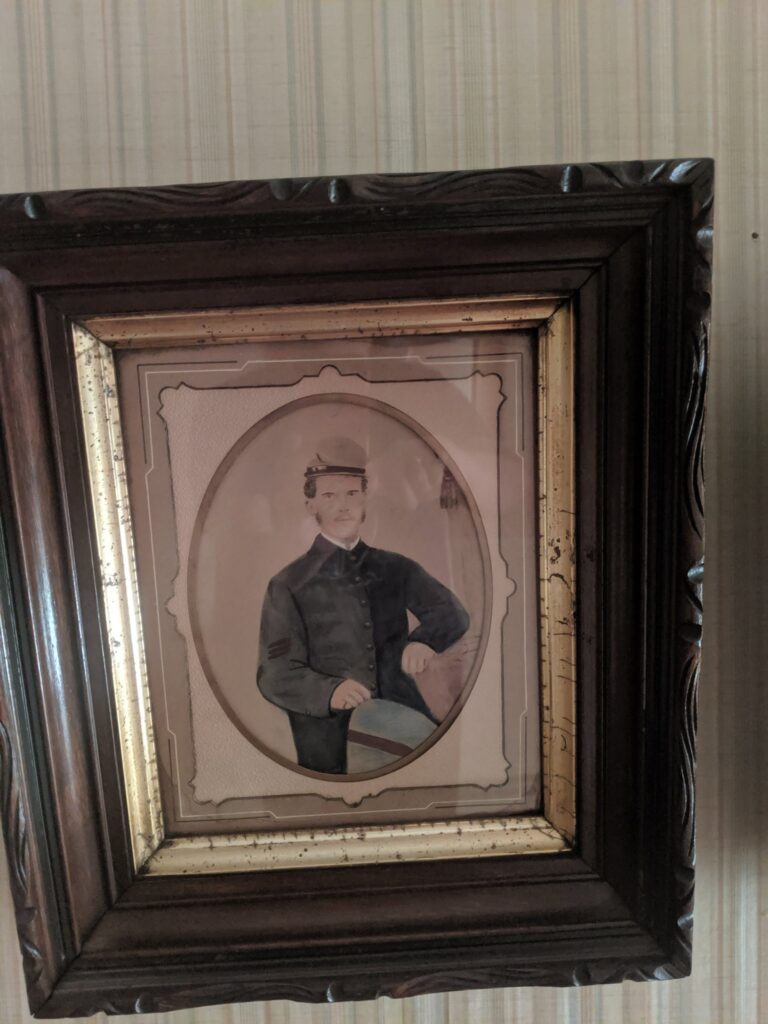
Defeat of General Braddock, in the French and Indian War, in Virginia in 1755 / John Andrew, sc.
No known restrictions on publication.
As Independence Day 2023 approaches, I’m attempting to honor my ancestor, Nathaniel Couch, who played a key role in the founding of the United States. This includes fighting in the Seven Years War (French and Indian War) for the British and building Fort Couch in today’s western Pennsylvania to provide protection for the community. He then fought in the Revolutionary War for the Colonies and provided shelter for the rebel forces during the Whiskey Rebellion.
That’s a lot to pack into one lifetime! For the past couple of days, my two sons and I visited forts, museums, and a cemetery to try to trace some of his life. Two months ago, we also spent a few days in Winchester, VA where Nathaniel may have been born in 1725.

Here’s what I know so far.
Nathaniel Couch: Family Life
Around 1748, Nathaniel married Abigail Wilson, daughter of Josiah Wilson, Jr. and Elizabeth Spring. She’d been born in about 1728. The couple had eight children:
- Joseph (est. 1749-1837)
- Sarah (est. 1765-1830)
- Henry (June 18, 1767-June 18, 1828)
- Mariam (est. b. 1769)
- Benjamin (est. 1771-1844)
- Freelove (est. b. 1778)
- Nathan, Jr. (est. 1779-1846)
- Phillip
You’ll notice a big gap between the birth of his first and second child. That may be because of the Seven Years War (1754-1763). Cut down to its very basics, both the French and the British wanted to claim land in North America—land that numerous Indian tribes had lived in for thousands of years. Considered to be prime land: the Ohio River Valley. What that led to: war.
Marching Towards Fort Duquesne
In 1754, the French had established Fort Duquesne along the forks of the Ohio River in modern-day Pittsburgh. (Note: my sons and I walked along the outline of where this fort once stood.) British General Edward Braddock marched against this fort with his troops, which also included Indian allies and some American provincial troops—including Nathaniel Couch who fought under a twenty-one-year-old, little-known man, George Washington, as one of the Virginia Rifles. (A Genealogical and Biographical History of Allegheny County, Pennsylvania, edited by Thomas Cushing in 1889).
Fighting against the British were French troops, Canadian ones, and Indian tribes who had aligned with them. This led to an event on July 9, 1755 now known as Braddock’s Defeat. After three brutal hours of fighting, the British forces were defeated, Braddock was mortally wounded, and many Virginians were killed, including some by friendly fire. British soldiers had panicked and fired on the Colonists because they thought they might be unfriendly Indians. Nathaniel was one of the lucky ones and was able to retreat. (Note: My sons and I ran out of time and didn’t get to see the site of Braddock’s Defeat.)
At some point, Nathaniel moved to Pennsylvania. His third child, Henry, seems to have been born in 1767 in St. Clair, Allegheny, Pennsylvania. So, by this time, the family had apparently moved west. In this era, that county would have been on the edge of the frontier with wilderness further west.
If, as some evidence suggests, Nathaniel built Fort Couch on his farm, Titlenure, as protection during attacks against the British by the French and Indians, he perhaps left his family in Virginia for the time being. The fort may have actually been a “large, rugged cabin in the center of a large clearing” that would serve as a place for nearby people to gather when in danger. There are no specific records of Native American attacks on the fort.
In “The Settlers’ Forts of Western Pennsylvania” by John DeMay, the author suggests that Nathaniel “came here to stay in 1769.” The Cushing book refers to his fort as the county’s first settlement, and this is where he and Abigail had several more children. According to Cushing, “They were all imbued with a spirit of patriotism,” and this patriotic spirit is surely what caused Nathaniel to fight in the Revolutionary War, which will be the subject of my next post.
As an FYI, I’m directly descended from Nathaniel’s son Henry. He married Catherine Carmichael, daughter of Private John Carmichael and Mary Elizabeth McCollom, around 1791. They had a daughter, Eliza, in 1813. She married Andrew Hanna on December 8, 1832; Andrew fought as a Union soldier and died in the war in August 1862. They’d had four children, and I’m descended from Thomas, born around 1838. He married Georgianna Harvey, and they had five children. Thomas also fought in the Civil War, but he survived.

I’m then descended from Thomas and Georgianna’s daughter, Mardie E. Hanna, born in 1873, who married Charles McDonald. They had one child, Beatrice, who married Carl Boyer, Sr. They had two children, Carl, Jr. and Thomas Harvey. My father, Tom, married Jere Lee Taaffe, and they had two children: me and then my sister, Tracy. I married Don Sagert and our two boys, Ryan and Adam, are going on all of these history trips with me!